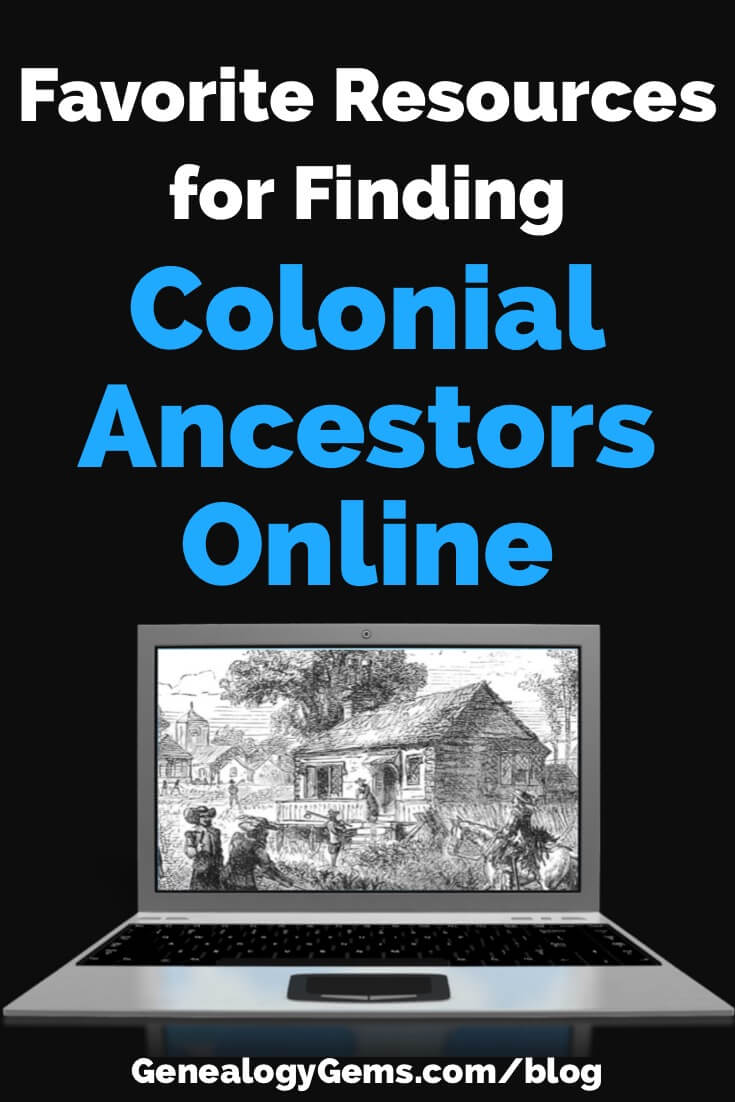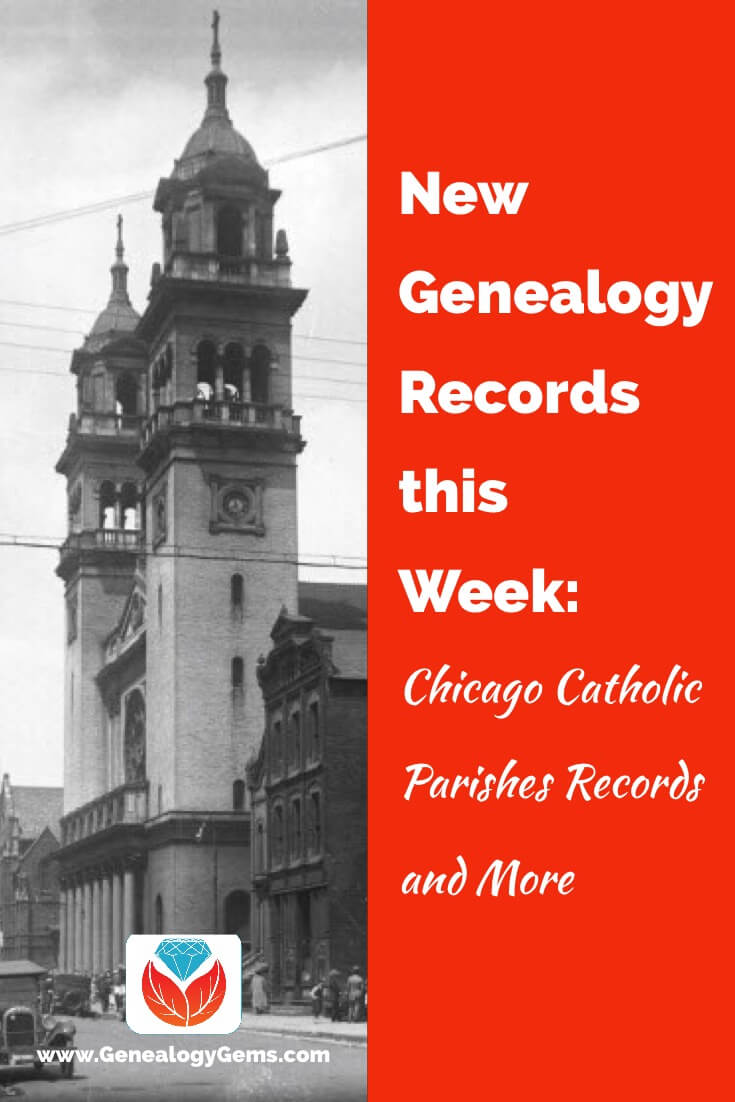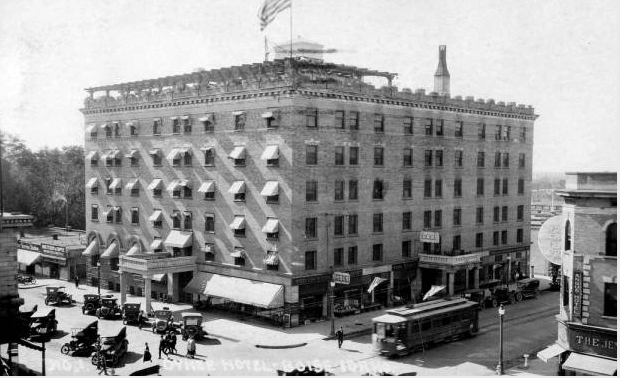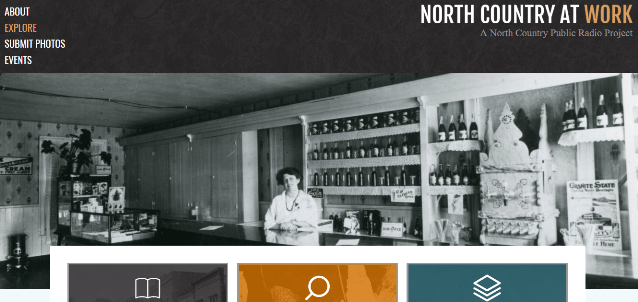by Lacey Cooke | Oct 23, 2018 | 01 What's New, Colonial (US.), Legacy Tree Genealogists, United States
Colonial ancestors pose a unique challenge to the genealogist in that they often appear in many online family trees, but those trees frequently lack sufficient documentation. Eliminating the purely speculative and identifying verified relationships and accurate data is the goal. Here are three of our favorite online resources for finding colonial ancestors.
Thanks to Bob Call and the experts at Legacy Tree Genealogists for this guest post!
1. AmericanAncestors.org
The fantastic subscription-based website, AmericanAncestors.org, is the creation of the New England Historic Genealogical Society. NEHGS was founded in 1845 and is the oldest genealogical society in the United States. As such, they have had nearly two centuries to gather and preserve materials pertinent to family history. According to their “about” page, AmericanAncestors.org presents “more than 1.4 billion records spanning twenty-two countries” and is “one of the most extensive online collections of early American genealogical records.”
Of the 435 databases hosted on AmericanAncestors.org, 286 are focused on pre-1800 records. These databases include vital records, censuses, migration, bible, cemetery, tax, voter, property, probate, court, and military records as well as family histories, local histories, biographies, reference material, and periodicals. Searching these records is easy with the “Search All Databases” page, which allows the user to add a variety of search terms—names, years, record types, locations, keywords, and additional family members. With so many record types available to the genealogist, the databases at AmericanAncestors.org are a must for colonial family history research.
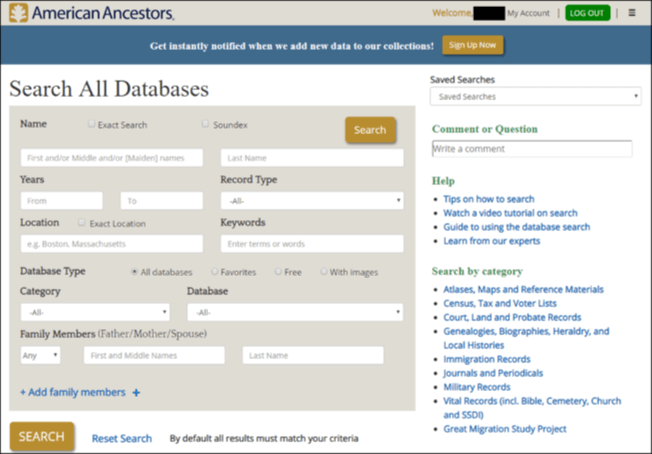
Besides research databases, AmericanAncestors.org offers access to a number of other helpful services. Two of these services are the Digital Collections and the Library Catalog both of which are portals to the extensive collections housed at the NEHGS library in Boston, Massachusetts. When searching the Digital Collections webpage the family historian will find personal family papers such as photographs, diaries, and letters as well as records created by non-family entities like organization and business records and newspapers. The Digital Collections section of the website also has a focus on the history of the Jewish community in the Boston area and offers material helpful to both the historian and genealogist.
The Library Catalog gives the family historian the ability to begin their research of NEHGS’s extensive collections at home. Of course, a catalog is different than a database in that a catalog lists the titles of the library’s holdings and not every name mentioned within each item. However, if planning a trip to NEHGS to conduct research, it would be wise to have a starting point for your research—that way you can hit the ground running and make the most of your time at the library itself. Use the catalog by searching family surnames and ancestral residences to find books, manuscripts, or photographs that may be beneficial to your research.
2. Digitized Books
Our experience reveals that many online trees presenting colonial American ancestries are based upon genealogies published in the nineteenth and twentieth centuries (although the online trees themselves frequently do not cite the published genealogies). Genealogies published in the nineteenth century and early twentieth century are not always accurate and rarely included extensive citations supporting each statement of fact as contemporary genealogies should, but they can still be helpful. These genealogies occasionally referenced original sources (such as wills or deeds) or made blanket statements about what type of records were used (like family correspondence or county records).
Additionally, the printed genealogies provide a clearer picture of what previous generations believed about their genealogy before the advent of the internet, which escalated confused and inaccurate pedigrees because of the ease of data sharing and a general lack of quality control. Thus, published genealogies can provide important clues about colonial American families. Accessing these published genealogies was much more difficult just a few years ago, but thanks to websites like Archive.org and Google Books many can be viewed right at home. These organizations have taken the time to digitize genealogies which are now in the public domain due to copyright laws.
3. The FamilySearch Catalog
One underutilized resource on FamilySearch.org is the FamilySearch Catalog (formerly known as the Family History Library Catalog). This tool inventories all of the holdings at the massive Family History Library in Salt Lake City, Utah. A majority of the holdings at the Family History Library are on microfilm, which FamilySearch plans to digitize by 2020. While some of these digitized microfilms have been organized into databases available through FamilySearch’s “Historical Records” portion of the website, many are only found listed as microfilm in the FamilySearch Catalog. In other words, there may be a collection of digitized microfilms that can only be viewed online by clicking on the link in the FamilySearch Catalog and will not be found in a “Historical Records” database.
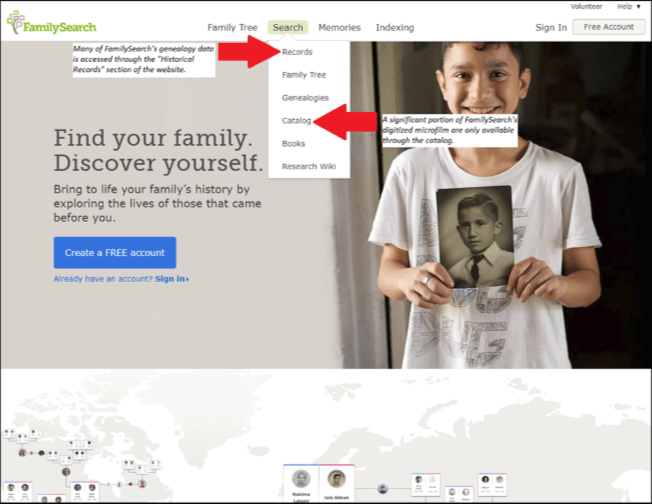
So what does this mean for researching colonial American ancestors? There are two record types in particular where the FamilySearch Catalog becomes exceptionally beneficial to colonial research—property and probate records. These record types are useful because they can prove, through both direct and indirect evidence, family relationships in times or places where other documents (like vital records and census) are lacking. However, because property and probate records are difficult to index there are fewer databases in FamilySearch’s “Historical Records” which focus on them. This is where the FamilySearch Catalog comes in; many microfilms of probate and property records have been digitized and are accessed in the catalog. These high-quality digital images—often of better quality than the microfilm itself—can be clicked through in search of an ancestor’s property or probate records.
Here’s an extra tip: Some of the probate records that have been digitized in the FamilySearch Catalog can only be viewed at the Family History Library or a Family History Center—due to agreements the Family History Library has with the original agencies, the images are locked and cannot be accessed at home. If you can’t make it to your local Family History Center, one workaround is checking Ancestry.com to see if that database has the probate records in question. Ancestry’s probate databases include a searchable index, but these indexes are very incomplete and it is best to browse through the images.
Using these resources and many others, our team at Legacy Tree Genealogists has assisted many with their Colonial American research problems and would be glad to assist in discovering your Colonial ancestors as well.
Bob Call is a researcher for Legacy Tree Genealogists, a worldwide genealogy research firm with extensive expertise in breaking through genealogy brick walls. Whether you’ve got colonial ancestors or ancestors all over the world, you can get expert research help and access to records otherwise unavailable when you partner with Legacy Tree Genealogists. Visit their website to learn more and get a free consultation!
Exclusive Offer for Genealogy Gems readers: Receive $100 off a 20-hour research project using code GGP100!
Disclosure: This article contains affiliate links and Genealogy Gems will be compensated if you make a purchase after clicking on these links (at no additional cost to you). Thank you for supporting Genealogy Gems!
by Sunny | Jun 8, 2018 | 01 What's New, Records & databases |
Chicago Catholic parish records top this week’s list of new and updated U.S. genealogy records online. Also: Japanese internment camp testimonies; AK and NC WWI digital archives; CO, GA and NC school records; GA and MT newspapers; ID, NY and OR photo archives; IL maps; MA church records; VA military casualties and WA history.
Featured: Chicago Catholic parish records
Genealogy Giant subscription website Findmypast.com has added more Chicago Catholic parish records to its unique and valuable Catholic Heritage Archive. During the nineteenth century, Chicago was one of the fastest growing cities in the world, with the population increasing twenty-fold between 1860 and 1910 to make it the fifth largest city in the world. Chicago was a veritable boomtown, with its population swelling with European emigrants from Europe, particularly Czech and Polish. The Archdiocese of Chicago was first established as a diocese in 1843 and later as an archdiocese in 1880. It serves the Catholic population of Cook and Lake Counties in northeastern Illinois.
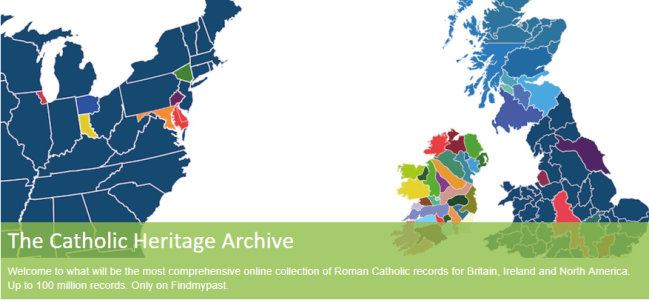
Recently added are:
- Over 1.2 million additional records from the mid-1800s up to 1925 have been added to the existing collection of Chicago Catholic Baptisms. Records reveal the date and location of baptism, the names of parents, and their residence. Each result will provide a transcript and image of the original baptism register.
- Over 597,000 additional records have been added to Chicago Catholic Marriage records. Each result includes a transcript and an image of the original marriage register that may reveal the couple’s marriage date, marriage location, the names of their parents, and the names of any witnesses.
- Over 229,000 recently added burial records have been added to Chicago Roman Catholic Parish Burials. Images may reveal additional details such as cause of death, residence, place of birth, father’s name, mother’s name, and the name of the priest who conducted the service.
- More than 430,000 assorted Catholic congregational records from across the archdiocese reveal biographical details as well as where and when your ancestors worshiped. Searched indexed images of an assortment of records.
- Not finding your ancestors, or want to dig deeper into these records? You can now delve through original registers of baptisms, marriages, and burials page by page in the image collection Chicago Roman Catholic Parish Registers.
More U.S. genealogy records now online
Japanese internment camp testimony. A new digital collection has launched containing testimonies relating to the WWII-era internment of U.S. residents of Japanese descent in the American Commission on the Wartime Relocation and Internment of Civilians (CWRIC) hearings that took place in 1981. According to an online article in the Northeastern Illinois University Independent, “The collection contains the hearings, testimonies and individual accounts that were held in the internment camps; these hearings were held to investigate the ethical and constitutional objections” of the executive order that led to the forced detainment of about 120,000 Japanese-Americans for about three years.
Arkansas. The Arkansas State Archive has launched “Arkansas in the Great War,” a three-part online exhibit chronicling the history of the state during World War I. According to the state archives blog, “The exhibit was created through Google Arts & Exhibits and contains over 150 high-resolution images of photographs, letters, government documents and maps that tell the story of Arkansas’s involvement in the war. The first section, ‘Mobilizing the State for War,’ profiles Arkansas before the U.S.’s entrance into the war and how the state mobilized to meet the challenge. Part two, ‘The War at Home,’ examines the domestic impact the war had on Arkansans and explores the contributions of women and African Americans to the war effort. The last section, ‘In the Trenches,’ details Arkansans serving in Europe and the events immediately following the end of the conflict.”
Colorado. The University of Denver’s 123-year-old student newspaper, The Denver Clarion, has been archived online at the university’s Special Collections website. The issues aren’t listed fully chronologically and the collection is still growing; check back to find the issues you’re looking for.
Georgia. The Digital Library of Georgia has added new content documenting Atlanta’s Interdenominational Theological Center and Morehouse, Morris Brown, and Spelman Colleges. Yearbooks, academic journals, alumni news, photos, course catalogs and more are now available for these historically African American colleges. Click here to read more and access the collections.
The Digital Library of Georgia has also added newspapers covering Early, Montgomery and Toombs Counties in South Georgia to its Georgia Historic Newspapers website. The collection covers nearly 27,000 digitized pages from six different newspapers dating from 1863 to 1927.
Idaho. The Idaho Transportation Department has launched an archive of 30,000 historic photos it has taken over the years that reflect the state’s history. According to the East Idaho News, “It allows anyone interested to easily access photos as old as 100 years, giving them a look at what the Gem State used to be like. Since its launch a little over two weeks ago, the department has had over 20,000 people access the database.” A collection of historic postcards is also part of the digital archive. Click here to view more about the downtown Boise hotel shown here.
Illinois. Southern Illinois University has published a new online collection of current and historical maps. According to the announcement, “More than 850 maps from the library’s collection have been digitized….The Maps of Southern Illinois Online collection covers the city of Carbondale and the rest of Jackson County as well as other Southern Illinois counties. Included are maps showing county roads, land ownership, proposed developments, aerial photographs, and coal, oil and gas mining maps.
Massachusetts. The New England Historic Genealogical Society has been busily adding more digitized records to its subscription collection at AmericanAncestors.org. Among their recent additions are:
- Norfolk County, MA: Probate File Papers, 1793-1877. Made possible through our partnership with the Massachusetts Supreme Judicial Court Archives, this database contains 20,904 probate cases filed between 1793 and 1877, and more than 515,000 individual file papers.
- More parishes added to Roman Catholic Archdiocese of Boston Records, 1789-1900. New parishes include St. Mary (Randolph), St. Mary (Marlborough), St. Patrick (Stoneham), St. Mary (Lynn), St. Joseph (Haverhill), Immaculate Conception (Marlborough) and St. Margaret (Dorchester).
- Digitized records from two Boston churches, the Federal Street Church(1787 to 1796) and the New North Church (1798 to 1814), as well as the West Church of Granby, Massachusetts.
- FREE TO VIEW: the digitized diary of Mehitable Williams of Mansfield, Massachusetts (written between 1765 and 1770), and the journal of Richard Hazen (written while he surveyed the coast of Maine from 1750 to 1751).
- More than 1,500 pages of the Hebrew Immigrant Aid Society (HIAS), Boston record collection; members can click here to access the collection and search case files. Anyone may read a related HIAS case study, “Effectively Stateless,” posted on Vita Brevis.
Montana. Over 1.6 million pages of the Billings Gazette have been digitized as part of a partnership with Newspapers.com, reports the Billings Gazette online. Newspapers.com subscribers may click here to explore that paper and the rest of the site’s offerings. Another tip from the Billings Gazette: “Lee Enterprises, which owns The Gazette, also has a similar agreement that digitized its sister publications in Butte, Helena, Hamilton and Missoula. (The Gazette’s archives may be accessed with a subscription at billingsgazette.com/archives.)”
New York. North Country Public Radio has announced the launch of its new archive, “North Country at Work,” covering upstate New York history. According to the site, its purpose is “exploring the work history and contemporary economic landscape of each of the communities in the Adirondack North Country. Our starting point is photographs—images of people at work, the tools they use, the spaces their work occupies or impacts…We expand to personal stories, oral histories, and other content to deepen our understanding of how the livelihoods of people across northern New York looked in earlier times.” The public is invited to contribute.
North Carolina. The State Archives has added 60 new items to its North Carolina in World War I digital archive. Among the items are correspondence from a woman at the Front, war journals, field notebooks and other papers. Click here to read about and access the new additions.
Also for North Carolina, now at Digital NC you can “browse through 175 issues of The Stentorian, the North Carolina School of Science and Mathematics’ (NCSSM) student-run newspaper,” states the Digital NC blog. “NCSSM is a residential high school located in Durham, NC. It was founded in 1980 to provide a two-year public education to high school students focusing on science, math, and technology. The Stentorian covers student life and school events spanning the last four decades, from 1981 to 2017.” Click here to read more.
Oregon. The Portland Mercury reports that “The Multnomah County Library just launched a new digital collection of photos and documents chronicling Portland’s African American community over the years. Called ‘Our Story: Portland through an African American Lens,‘ the collection melds archives from Oregon Historical Society Research Library, Oregon State University, and City of Portland Archives.”
Virginia. A newspaper, The Virginian-Pilot, has launched an online database “of every Virginian who lost his or her life serving abroad in the military since the Sept. 11 terror attacks. The database includes a short story about each one, compiled from news reports across the country, obituaries, memorial websites, social media posts and YouTube videos, among others.”
Washington. A partnership between state and educational leaders has produced Primarily Washington, “an online education portal designed to bring lesson plans together with the primary sources in our collections,” according to the state Secretary of Education’s blog. “The Primarily Washington portal currently contains 6 lesson plans, on topics including the Everett Massacre, Territory to Statehood, teaching elections, and Legacy Washington’s Korea 65 exhibit. Drawing from our plethora of newspapers and items in our Classics in Washington History digital collection, more lesson plans will be added this summer. The portal also presents the Emma Smith Devoe Scrapbook Collection, a wide-ranging set of early 20th-century newspaper clippings and other documents about important contemporary topics such as women’s suffrage.”
Keep track of your online discoveries
Ever found something online–perhaps at a site like those mentioned above–then forgotten where it was? Watch Lisa Louise Cooke’s free video for FANTASTIC tips on organizing your online life. Your searches, your discoveries, your emails–whatever content you use online, Lisa’s got a way to organize it so you can find it again!
Disclosure: This article contains affiliate links and Genealogy Gems will be compensated if you make a purchase after clicking on these links (at no additional cost to you). Thank you for supporting Genealogy Gems!
by Lisa Cooke | Sep 4, 2015 | 01 What's New, Ancestry, images
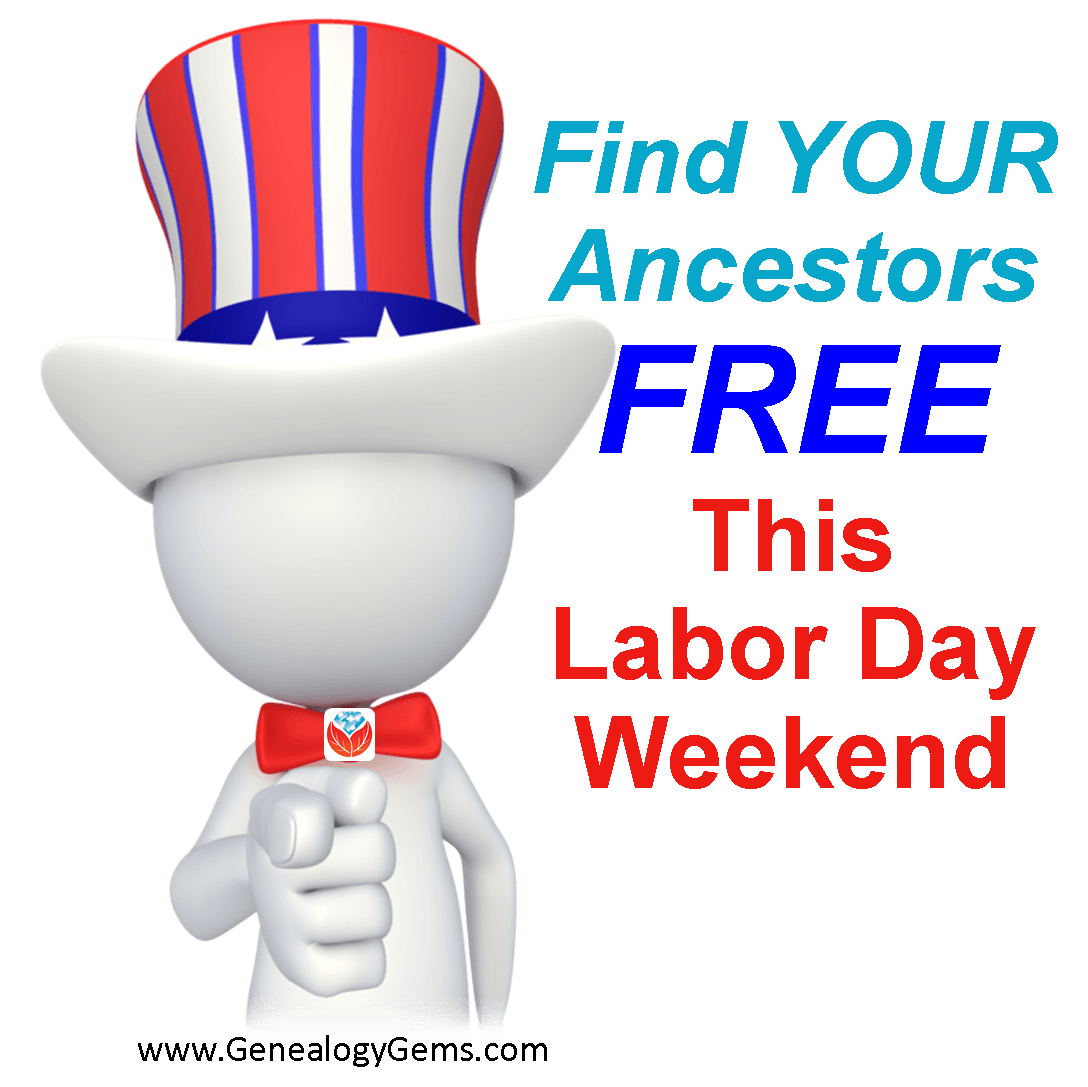 Both Ancestry and the New England Historic Genealogical Society are offering free access to selected U.S. databases in celebration of the Labor Day holiday.
Both Ancestry and the New England Historic Genealogical Society are offering free access to selected U.S. databases in celebration of the Labor Day holiday.
Through next Wednesday, September 9, the New England Historic Genealogical Society (NEHGS) is offering free access to several of its census, tax and voter databases on AmericanAncestors.org.
“The Census, Tax, and Voter Lists category is a collection of 40 separate databases containing a range of resources to provide information about the families who resided in the New England states between the 18th and 20th centuries,” says a press release.
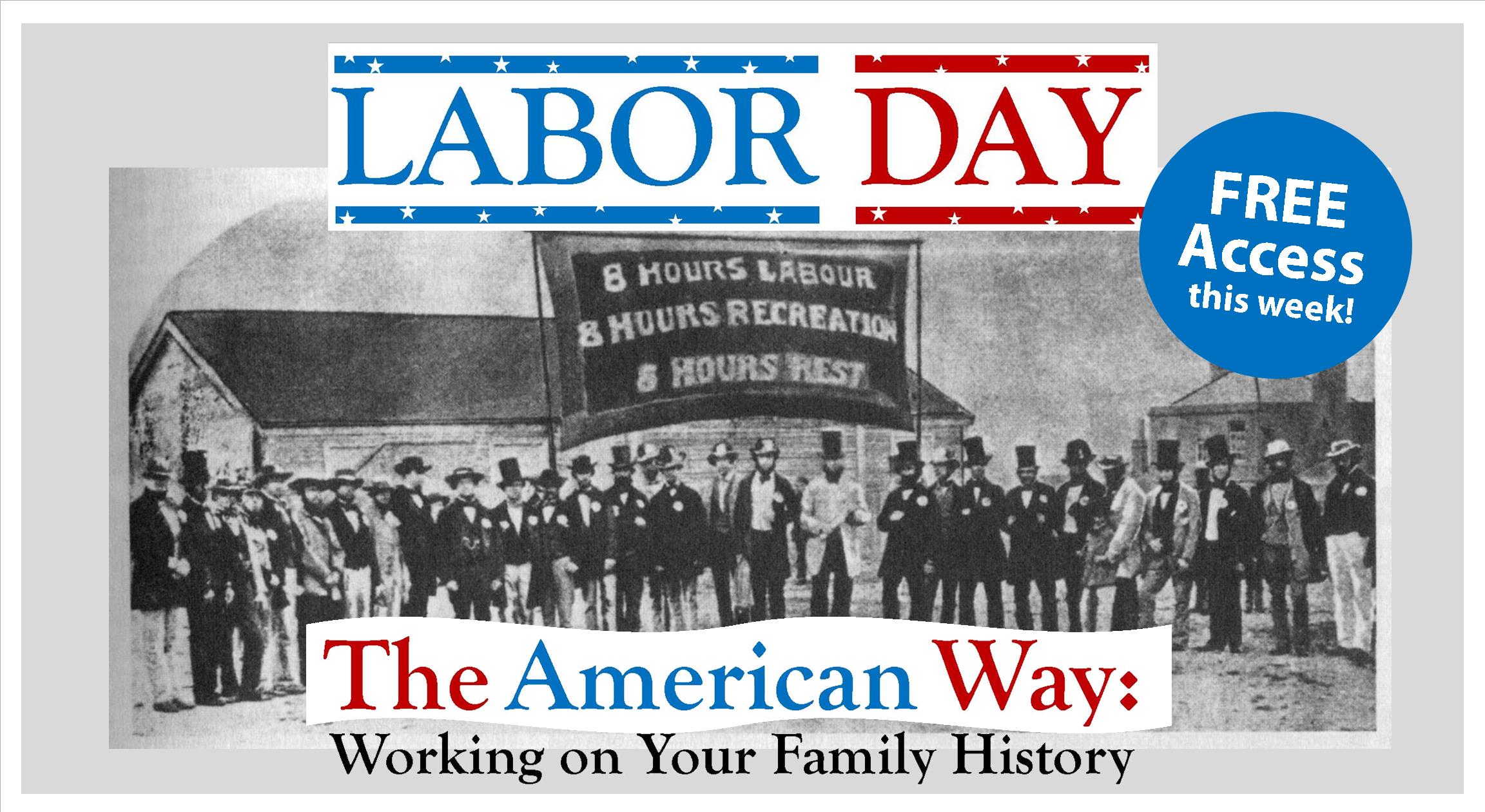 “Other broader databases help to trace families as they moved to other areas of the United States. And a handful of European databases within the collection can assist researchers attempting to further document their family’s heritage.” Transcripts of U.S. federal censuses through 1880 and several state and town tax records are also included.
“Other broader databases help to trace families as they moved to other areas of the United States. And a handful of European databases within the collection can assist researchers attempting to further document their family’s heritage.” Transcripts of U.S. federal censuses through 1880 and several state and town tax records are also included.
Registration is required at AmericanAncestors.org as a free guest user to take advantage of this offer.
As we reported yesterday, Ancestry is also offering free access to selected U.S. records over the Labor Day holidays. Their access includes (and celebrates the release of) an enormous new collection of U.S. wills and probate records. That collection alone is worth a fresh round of Ancestry searches–more than 10 million people are indexed from 170 million digitized pages of estate records from across all 50 states!
Do you know anyone with U.S.–and especially New England–roots who would want to know about these offers? Please share this post!
Resources
Disclosure: This article contains affiliate links and Genealogy Gems will be compensated if you make a purchase after clicking on these links (at no additional cost to you). Thank you for supporting Genealogy Gems!
by Lisa Cooke | Jul 1, 2015 | 01 What's New, images, Records & databases, United States
 In honor of Independence Day in the United States, AmericanAncestors.org is offering free access to databases on early New England ancestors starting TODAY through July 8.
In honor of Independence Day in the United States, AmericanAncestors.org is offering free access to databases on early New England ancestors starting TODAY through July 8.
If you have Mayflower, Pilgrim or Puritan ancestors (or want to confirm the rumor that you do!), you’ll want to take advantage of this offer from the New England Historic Genealogical Society. For many years the society has been researching “the 20,000 men, women, and children who crossed the Atlantic between 1620 and 1640, seeking opportunity and relief in New England.”
The Great Migration Study Project, as their work is known, has resulted in several databases, nine of which are open to the public for FREE during the first week of July 2015:
The Great Migration Begins. This database “attempts to identify and describe all those Europeans who settled in New England prior to the end of 1633,” states an NEHGS press release. “As a rough estimate, about 15 percent of the immigrants to New England arrived in the fourteen years from 1620 to 1633, with the remaining 85 percent coming over in half as many years, from 1634 to 1640.”
The Great Migration Newsletter. “This database comprises Volumes 1 through 20 of the Great Migration Newsletter, published between 1990 and 2011. Each 32-page issue contains one or two feature articles, a column with editor’s comments, and a review of recent literature on the Great Migration. Each issue also contains a section with detailed coverage of one of the towns settled during the Great Migration, or of a specific critical record, or group of records.”
The Great Migration: Immigrants to New England, 1634-1635, Volumes I—VII, A-Y. (7 separate databases) “As many as 2,500 people immigrated in 1634 and again in 1635….In May 1634, the population of Massachusetts doubled in just one month….Each alphabetical entry for a family or individual includes:
- Place of origin, if known
- Date and ship on which they arrived in New England, if known
- Earliest known record of the individual or family
- First residence and subsequent residences, when known
- Return trips to their country of origin, whether temporary or permanent
- Bibliographical information such as birth, death, marriage(s), children, and other important family relationships, church memberships, and civil and military offices held.”
Click here to access these databases for free between July 1-8, 2015. (Registration at AmericanAncestors.org is required as a FREE Guest Member.)
 Looking for more FREE New England genealogy resources? Check out these blog posts!
Looking for more FREE New England genealogy resources? Check out these blog posts!
by Lisa Cooke | Jun 19, 2015 | 01 What's New, Records & databases
Every Friday, we blog about new genealogy records online. Do any of the collections below relate to your family history? This week we cover burials in Cleveland, Ohio; an Oakland, CA newspaper; travelers to the U.S. via Canada, early Vermont pioneers and a register of WWI soldiers’ mothers and widows.
CLEVELAND (OH) BURIALS. The Cleveland Catholic Diocese has posted an index to burials. According to the site, “The following cemeteries have been uploaded into the centralized database: All Saints, Northfield; All Souls, Chardon; Resurrection, Valley City; Holy Cross, Akron; Holy Cross, Brook Park; and St. Joseph, Avon. Work is ongoing on the following cemeteries: Calvary, Cleveland; and Calvary, Lorain.” Registration is required but it is free.
OAKLAND (CA) NEWSPAPER. Nearly 400,00 pages of the Oakland Tribune spanning a full century (1874-1975) is now online at Newspapers.com. Oakland is in Alameda County and became an early terminus for the Transcontinental Railroad.
TRAVELERS TO U.S. VIA CANADA. Nearly 100,000 records appear in a new Ancestry database, U.S., Passenger and Crew Lists for U.S.-Bound Vessels Arriving in Canada, 1912-1939 and 1953-1962. “This collection contains forms, or passenger lists, submitted to the Immigration and Naturalization Service (INS) by airline captains and shipmasters,” according to the collection description. Records are included for the ports of Montreal, Quebec; Saint John, New Brunswick; Halifax, Nova Scotia; Vancouver, British Columbia; Victoria, British Columbia; Toronto, Ontario and Quebec Ports.
VERMONT PIONEERS. The New England Historic Genealogical Society has a new index online of Early Vermont Settlers to 1784. The collection description states, “This database contains modified Register-style genealogical sketches of every identifiable head of household who has been proven to reside in the present-day borders of Vermont by the year 1784. A list of children, their spouse(s), and all their vital records will accompany each sketch. We have noticed that the head of household occasionally dies outside of Vermont and many of the children live west of Vermont in New York, Ohio, and states westward. This database currently contains 34 sketches, 5,700 names and 2,700 records.”
WWI U.S. MOTHER’S PILGRIMAGE. Ancestry has updated its database of mothers and widows of U.S. soldiers killed in World War I and buried overseas, and were invited by the War Department to visit their loved one’s burial place. “Each record provides the name of widow or mother, city and state of residence, and relationship to the deceased. Additionally, information regarding the decedent’s name, rank, unit, and cemetery is provided.”
